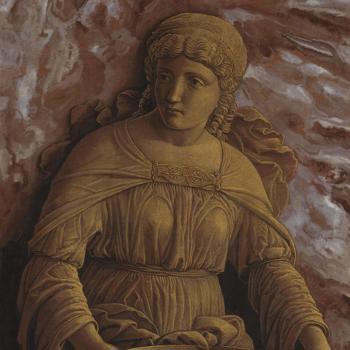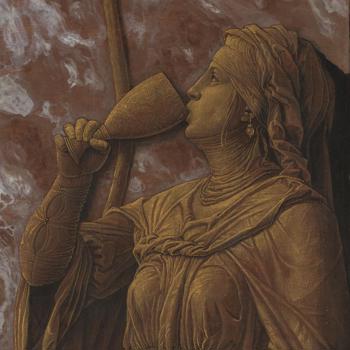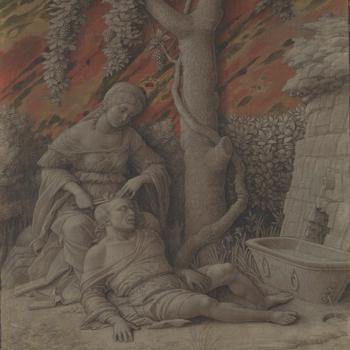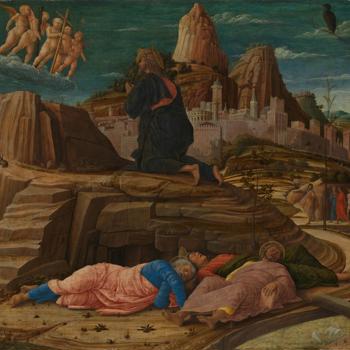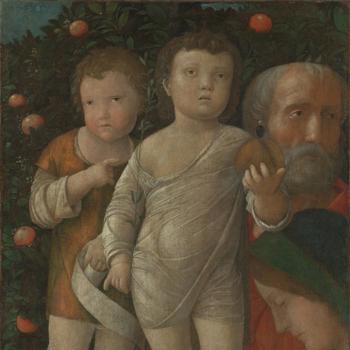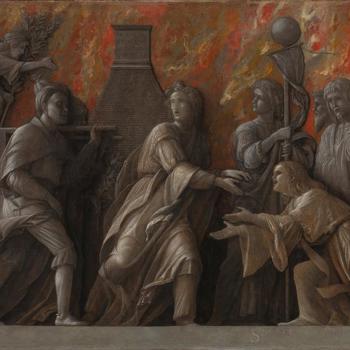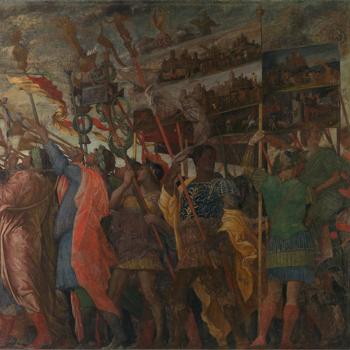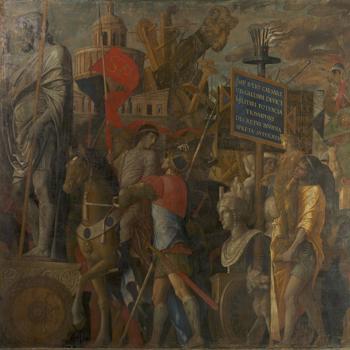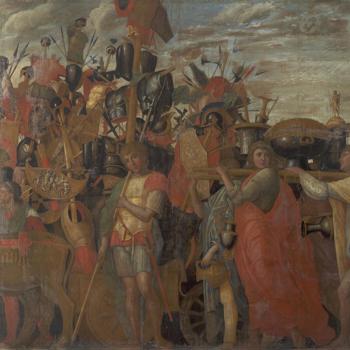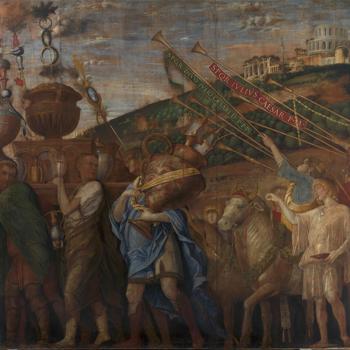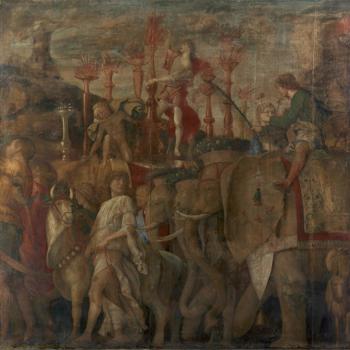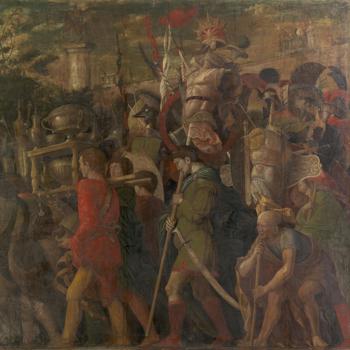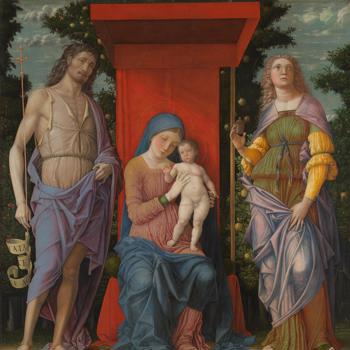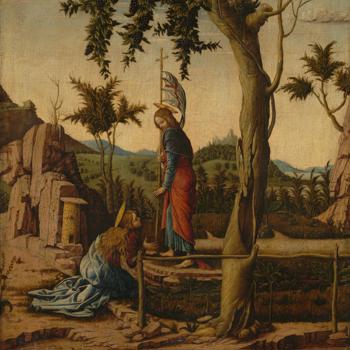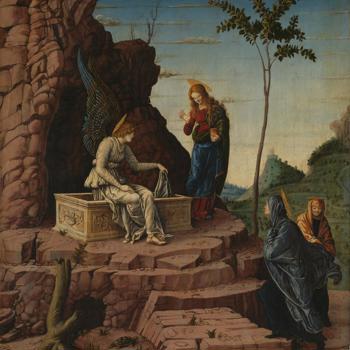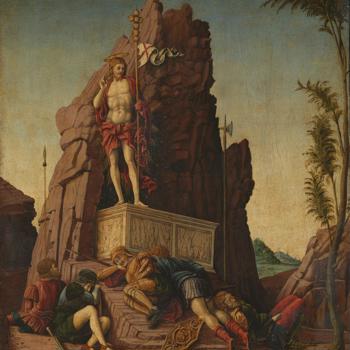Andrea Mantegna, The Vestal Virgin Tuccia with a Sieve
Two Exemplary Women of Antiquity
Viewed from a distance these two small pictures look like little bronze sculptures set against a pink and white marble background. They were known as bronzi finti – fictive bronzes. Mantegna painted several images mimicking antique sculpture, reflecting his interest in the art of antiquity but also showing off his ability to rival the work of sculptors using just paint.
The woman holding the sieve represents Tuccia, a renowned Vestal Virgin (a priestess who maintained the eternal fire at the temple of the chaste goddess Vesta in Rome). The woman with a goblet could be Sophonisba, a Carthaginian ruler who drank poison rather than be taken into slavery by the Roman general Scipio Africanus. Both were celebrated in the work of the fourteenth-century Italian poet Petrarch.
Archaeological discoveries of ancient artefacts sparked new appreciation of the classical world among the aristocracy. Mantegna’s inventive imitation of classical-style artefacts would have appealed to his sophisticated patrons – the ruling Gonzaga family – in Mantua.
Viewed from a distance these two small pictures look like little bronze sculptures set against a pink and white marble background. They were known as bronzi finti – fictive bronzes. Mantegna was particularly skilled at this trompe l‘oeil effect (’tricking the eye‘), and he painted several images mimicking antique sculpture. These reflected his personal interest in the art of antiquity but also showed off his ability to rival the work of sculptors using paint alone.
The woman holding the sieve represents a renowned figure from antiquity – the Vestal Virgin Tuccia. Vestal Virgins maintained the eternal fire at the temple of the chaste goddess Vesta in Rome. The woman with a goblet could be the legendary Sophonisba, a Carthaginian ruler who drank poison rather than be taken into slavery by the Roman general Scipio Africanus. Both women were celebrated in the work of the fourteenth-century poet, Petrarch.
Mantegna was fascinated by the classical artefacts that were being uncovered in Italy. His enthusiasm for and knowledge of the art and culture of ancient Greece and Rome were particularly prized in his lifetime: his own collection of classical objects was so important that in 1483 the great collector Lorenzo de’ Medici came to see it. In pioneering, inventive paintings he reimagined the art of ancient Rome by including classical-style objects and architectural features or, as here, recreating the effect of a classical technique.
Mantegna’s classical-style artefacts, which were also mentioned by contemporary Italian poets, would have appealed to his patrons – the ruling Gonzaga family – in Mantua, where he had become court painter in 1490. While we do not know the original location of the panels, we do know that the Marchioness of Mantua, Isabella d‘Este, had a picture of this kind in her studiolo, painted by Mantegna. Studioli were small rooms dedicated to the contemplation of the arts and scholarship: here Isabella could admire her personal collection of art and antiquities as well as play music, read and study.
It has been suggested that these two small vertical panels showing exemplary women of antiquity may have been commissioned for Isabella’s studiolo – but this is only speculation. They do not appear in any fifteenth-century inventories of the Gonzaga collection, although this might be because they were quite literally part of the furniture – fitted within panelling into the walls of the room. The fact that the figures are lit from the opposite side – Tuccia from the right and Sophonisba from the left – could be because they were made for specific positions on either side of a window.
Our two pictures have been linked with two others described as chiari e scuri (’dark and light‘, painted in monochrome, as here) by Mantegna in the eighteenth-century inventory of the last ruler of Mantua, Carlo Ferdinando Gonzaga, and then, later in the eighteenth century, in that of a German collector. The inventories refer to four pictures: two on panel, as here, and two on canvas. The two on canvas have been identified as Judith with the head of Holofernes, as described in the inventories, and Dido (both now in the Montreal Museum of Fine Arts). It is possible they were originally intended as a group; they all showed heroic historical women. This has added support to the idea that they might have been made for Isabella d’Este, herself a strong and powerful woman.

